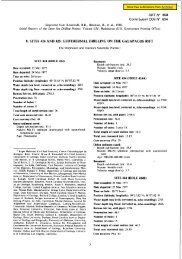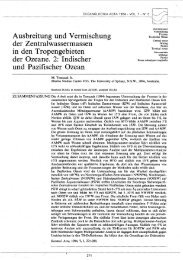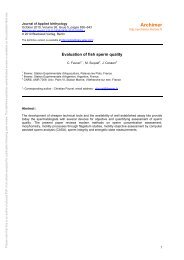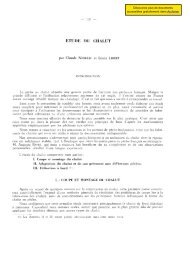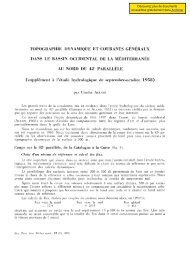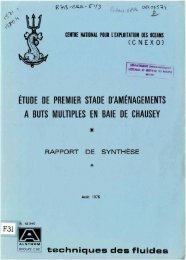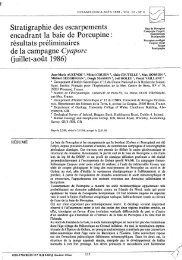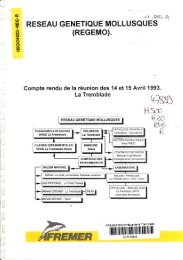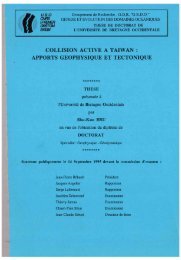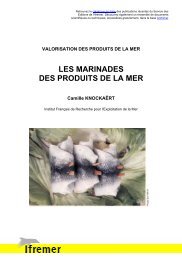Contribution à l'étude de virus de mollusques marins apparentés ...
Contribution à l'étude de virus de mollusques marins apparentés ...
Contribution à l'étude de virus de mollusques marins apparentés ...
You also want an ePaper? Increase the reach of your titles
YUMPU automatically turns print PDFs into web optimized ePapers that Google loves.
736<br />
Material and methods<br />
Samples of moribund hatchery-reared larvae and sampies<br />
of moribund cultured 3-7 month old oyster spat were<br />
fixed in Davidson's fluid for light mieroscopy examination.<br />
Sampi es were then <strong>de</strong>hydrated through an ascending<br />
ethanol series, eleared in xylene and infiltrated with paraffin<br />
on a tissue processor. Following these differenl steps,<br />
they were embed<strong>de</strong>d in paraffin, sectionned at 3 or 4 I!m,<br />
then slained by Hematoxyline Eosine (HIE) and carefully<br />
checked for lesions using a photomicroscope. The nueleal<br />
reaction of Feulgen and Rossenbeck was also used on sorne<br />
sli<strong>de</strong>s.<br />
Sampi es of healthy wild-type larvae, samples of healthy<br />
or affected by mo<strong>de</strong>rate mortality cultured young oysters,<br />
and young spat survivors ta ken one to four months after<br />
reported high mortalities were also analysed with the same<br />
protocol.<br />
For transmission electron mieroscopy, larvae and pieces<br />
(gill, mantle and digestive gland) of young spat were<br />
flXed 1 h in cold 2.5 % glutaral<strong>de</strong>hy<strong>de</strong> in cacodylate buffer<br />
and post-fixed in 1 % osmium tetroxy<strong>de</strong> in the same<br />
buffer. Tissues embed<strong>de</strong>d in Epon were cut on a LKB<br />
ultramicrotome. One I!m sections for light microscopy<br />
were stained in 0.5 Ofo toluidine blue in 1 % aqueous<br />
sodium borate solution. Ultrathin sections were coUected<br />
on copper grids, stained with uranyl acetate and lead<br />
citrate. These sections were then examined with a lEOL<br />
lEM 1200 EX transmission electron microscope at 60 kV.<br />
Results<br />
COURSE OF DISEASE AND EPIDEMIOLOGY<br />
Three to four days after the spond, reduction in feeding<br />
and swimming larval activity were observed. Significant<br />
mortality occured by Day 6, with 100 % mortality<br />
by Day 8 to Day lOin most batches. Moribond iarvae showed<br />
a less exten<strong>de</strong>d velum and parts of this velum were<br />
often observed free in the pond water.<br />
For young spat, high mortalities occured in 1993 at the<br />
begining of luly in four different marine locations and<br />
in August for one batch (Table 1). 80 to 90 % mortality<br />
appeared in few days (less than a week). In t/lese. areas,<br />
high mortality was not <strong>de</strong>tected during this period among<br />
the Pacific oysters cultured around the batches in which<br />
fatality of young spat was reported (Table 1). One to four<br />
months after outbreaks, no mortality was observed among<br />
the surviving animais in two locations (Table 1).<br />
HISTOLOGICAL AND ULTRASTRUCTURAL OBSERVATIONS<br />
The main histological changes in the diseased larvae and<br />
spat consisted essentially of the presence of enlarged nuelei<br />
that showed abnormal shape and abnormal chromatin pattern<br />
throughout the connective tissues. The inflammatory<br />
79<br />
RENAULT (T.) ET COLLABORATEURS<br />
reaction around infected cells was reduced. For larvae,<br />
these lesions were observed into velum and mantle and for<br />
young spat these ab normal nuelei were reported into gill<br />
and mantle connective tissues. Accumulations of Feulgen<br />
positive material were <strong>de</strong>tected into nuelei and cytoplasm<br />
of affected cells.<br />
By electron microscopy, infected cells of larvae and<br />
young oysler spat exhibited intranuelear and inlracytoplasmie<br />
<strong>virus</strong>-like partieles. The nuelei conlained spherical or<br />
polygonal partieles, 70-75 nm in diameter (Figs la and lb).<br />
Sorne partieles appeared emply and consisled of structures<br />
assumed to be capsids ; olher contained an electron<strong>de</strong>nse<br />
core or a ovoid annular translucent core and were<br />
interpreted as being nueleocapsids (Figs la and lb). Sorne<br />
empty capsids appeared in the nueleus of infecled cells with<br />
a paracrystalline arrangement (Fig. 2). Naked cytoplasmie<br />
nueleocapsids were observed in the cytoplasm of<br />
myocytes (Fig. 3). Enveloped virions were <strong>de</strong>tected into<br />
cytoplasmic vesieles in other cells (Figs 4a and 4b) among<br />
bOlh larvae and young oysters. In cytolytic cells and in<br />
extracellular spaces, enveloped <strong>virus</strong>es were secn too (Figs<br />
5 a and 5b). These partieles consisted of a capsid with an<br />
electron-<strong>de</strong>nse nueleoid that was in turn surroun<strong>de</strong>d by<br />
a unit-membrane like structure (Figs. 5a, 5b and 6). The<br />
core was 54 nm in length and 36 nm in diameter when viewed<br />
longitudinally. Envelop and capsid were separated by<br />
a reduced electron-lucent gap. Fine filaments passed from<br />
the toroidal core to the insi<strong>de</strong> of the capsid (Fig. 6). The<br />
enveloped partieles, about 120 nm in diameter, exhibited<br />
spike-like protrusions on the surface (Fig. 5a).<br />
Ultrastructural changes of infected ceUs were found to<br />
be related to the presence of Ihe <strong>virus</strong> in lapanese oyster<br />
larvae and young spat. Abnormal accumulations of granular<br />
endoplasmic retieulum associated with large swollen<br />
mitochondria (Figs 7 and 8) and con<strong>de</strong>nsed nuelei with<br />
electron-lucent center (Fig. 9) or electron-lucent areas (Fig.<br />
10) were often observed in connective tissues of diseased<br />
animais. Moreover infected ceUs nuelei of affected larvae<br />
showed abnormal chromatin pattern with marginalisation<br />
(Fig. II). Degenerating and Iysing infected nuelei were frequently<br />
present too. A few large <strong>de</strong>nse granular bodies,<br />
lac king a bonding membrane were reported in infected<br />
eeUs. Other than fibroblastie eells, the infected ceU types<br />
eould bot he i<strong>de</strong>ntified with eertainty, but nueleocapsids<br />
oeeured in ceUs that might have been myocytes and partieles<br />
were also observed into the eytoplasm of cells assumed<br />
to be haemocytes.<br />
In this study, we found <strong>virus</strong>es in eight batehes of<br />
hatehery-reared larvae and in five batches of cultured<br />
young oyster spat (Table 1). On an other hand, histological<br />
and electron microseopy examinations on survivors of<br />
two batches of young oyster spat laken one to four months<br />
after high mortalities failed to reveal the presence of



